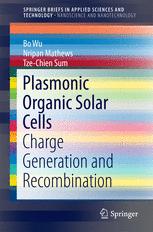

Most ebook files are in PDF format, so you can easily read them using various software such as Foxit Reader or directly on the Google Chrome browser.
Some ebook files are released by publishers in other formats such as .awz, .mobi, .epub, .fb2, etc. You may need to install specific software to read these formats on mobile/PC, such as Calibre.
Please read the tutorial at this link: https://ebookbell.com/faq
We offer FREE conversion to the popular formats you request; however, this may take some time. Therefore, right after payment, please email us, and we will try to provide the service as quickly as possible.
For some exceptional file formats or broken links (if any), please refrain from opening any disputes. Instead, email us first, and we will try to assist within a maximum of 6 hours.
EbookBell Team

4.1
70 reviewsThis book explores the incorporation of plasmonic nanostructures into organic solar cells, which offers an attractive light trapping and absorption approach to enhance power conversion efficiencies. The authors review the latest advances in the field and discuss the characterization of these hybrid devices using a combination of optical and electrical probes.
Transient optical spectroscopies such as transient absorption and transient photoluminescence spectroscopy offer powerful tools for observing charge carrier dynamics in plasmonic organic solar cells. In conjunction with device electrical characterizations, they provide unambiguous proof of the effect of the plasmonic nanostructures on the solar cells’ performance.
However, there have been a number of controversies over the effects of such integration – where both enhanced and decreased performance have been reported. Importantly, the new insights into the photophysics and charge dynamics of plasmonic organic solar cells that these spectroscopy methods yield could be used to resolve these controversies and provide clear guidelines for device design and fabrication.